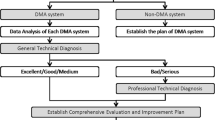Abstract
To analyze the factors affecting the leakage rate of water distribution system, we built a macroscopic “leakage rate–leakage factors” (LRLF) model. In this model, we consider the pipe attributes (quality, diameter, age), maintenance cost, valve replacement cost, and annual average pressure. Based on variable selection and principal component analysis results, we extracted three main principle components—the pipe attribute principal component (PAPC), operation management principal component, and water pressure principal component. Of these, we found PAPC to have the most influence. Using principal component regression, we established an LRLF model with no detectable serial correlations. The adjusted R 2 and RMSE values of the model were 0.717 and 2.067, respectively. This model represents a potentially useful tool for controlling leakage rate from the macroscopic viewpoint.






Similar content being viewed by others
References
Fagan JE, Reuter MA, Langford KJ (2010) Dynamic performance metrics to assess sustainability and cost effectiveness of integrated urban water systems. Resour Conserv Recycl 54(10):719–736
Kleiner Y, Rajani B (2001) Comprehensive review of structural deterioration of water mains: statistical models. Urb Water 3(3):151–164
Schouten M, Halim RD (2010) Resolving strategy paradoxes of water loss reduction: a synthesis in Jakarta. Resour Conserv Recycl 54(12):1322–1330
Morais DC, de Almeida AT (2007) Group decision-making for leakage management strategy of water network. Resour Conserv Recycl 52(2):441–459
Kingdom B, Liemberger R, Marin P (2006) The challenge of reducing non-revenue water in developing countries. How the private sector can help: a look at performance-based service contracting. Water Supply Sanitation Sect Board Discuss Pap Ser 8:11–24
Lu T, Liu Y, Li J et al (2013) Leakage situation and control solution of China water supply pipeline. J Fudan Univ (Natural Science) 52(6):807–810 (in Chinese)
Zarghami M, Akbariyeh S (2012) System dynamics modeling for complex urban water systems: application to the city of Tabriz, Iran. Resour Conserv Recycl 60(3):99–106
Francisco González-Gómez, García-Rubio Miguel A, Jorge Guardiola (2011) Why is non-revenue water so high in so many cities? Int J Water Resour Dev 27(2):345–360
Kang J, Zou ZH (2010) Time prediction model for pipeline leakage based on grey relational analysis. In: International Conference on Circuit and Signal Processing & 2010 Second IITA International Joint Conference on Artificial Intelligence. 2019–2024
Xu Q, Chen QW, Li WF et al (2011) Pipe break prediction based on evolutionary data-driven methods with brief recorded data. Reliab Eng Syst Saf 96(8):942–948
Zhang HW, Niu ZG, Chen CH et al (2001) Study on the prediction model for water supply net leakage. China Water Wastewater 17(6):7–9 (in Chinese)
Luo HL, Fu WX, Zhang Z (2010) Material and diameter selection of pipe network and its leakage control. Energy Conserv Environ Prot 1:44–46 (in Chinese)
Marunga A, Hoko Z, Kaseke E (2006) Pressure management as a leakage reduction and water demand management tool: the case of the City of Mutare, Zimbabwe. Phys Chem Earth 31(15):763–770
Pelletier GV, Mailhot A, Villeneuve JP (2003) Modeling water pipe breaks—three case studies. J Water Resour Plan Manag 129(2):115–123
National Bureau of Statistics of the People’s Republic of China. http://data.stats.gov.cn/search.htm?s=2016%20%E5%A4%A9%E6%B4%A5%20%E4%BA%BA%E5%8F%A3, 2016-04-04 (in Chinese)
Deng XT (2012) Urban water supply pipe network leakage factor analysis and control. Dissertation, School of Environmental Science and Engineering, Taiyuan University of Technology, Taiyuan, China (in Chinese)
Burn S, Desilva D, Eiswirth M et al (1999) Pipe leakage: future challenges and solutions. World Highw Routes Du Monde 19(4):80–90
Gupta R, Nair AGR, Ormsbee L (2016) Leakage as pressure-driven demand in design of water distribution networks. J Water Resour Plan Manag 142(6):04016005
Germanopoulos G, Jowitt PW (1989) Leakage reduction by excess pressure minimization in a water supply network. Proceedings of the Institution of Civil Engineers. Part 2. Res Theory 87:195–214
Wu TM (2013) Study on leakage cause and countermeasure of pipe network in Ningbo.http://www.chinacitywater.org/rdzt/guanwanglousun/7070-7.shtml,2013-05-21 (in Chinese)
Cui H (2007) Determination model for replacement of water pipeline. Eng Sci 9(9):68–71
Abdul-Wahab SA, Bakheit CS, Al-Alawi SM (2005) Principal component and multiple regression analysis in modelling of ground-level ozone and factors affecting its concentrations. Environ Model Softw 20(10):1263–1271
Statheropoulos M, Vassiliadis N, Pappa A (1998) Principal component and canonical correlation analysis for examining air pollution and meteorological data. Atmos Environ 32(6):1087–1095
Acknowledgements
This study was supported by the Ministry of Science and Technology of China (No. 2014ZX07203-009), the Fundamental Research Funds for the Central Universities, and the Program for New Century Excellent Talents at the University of China.
Author information
Authors and Affiliations
Corresponding author
Rights and permissions
About this article
Cite this article
Niu, Z., Wang, C., Zhang, Y. et al. Leakage Rate Model of Urban Water Supply Networks Using Principal Component Regression Analysis. Trans. Tianjin Univ. 24, 172–181 (2018). https://doi.org/10.1007/s12209-017-0090-x
Received:
Revised:
Accepted:
Published:
Issue Date:
DOI: https://doi.org/10.1007/s12209-017-0090-x




